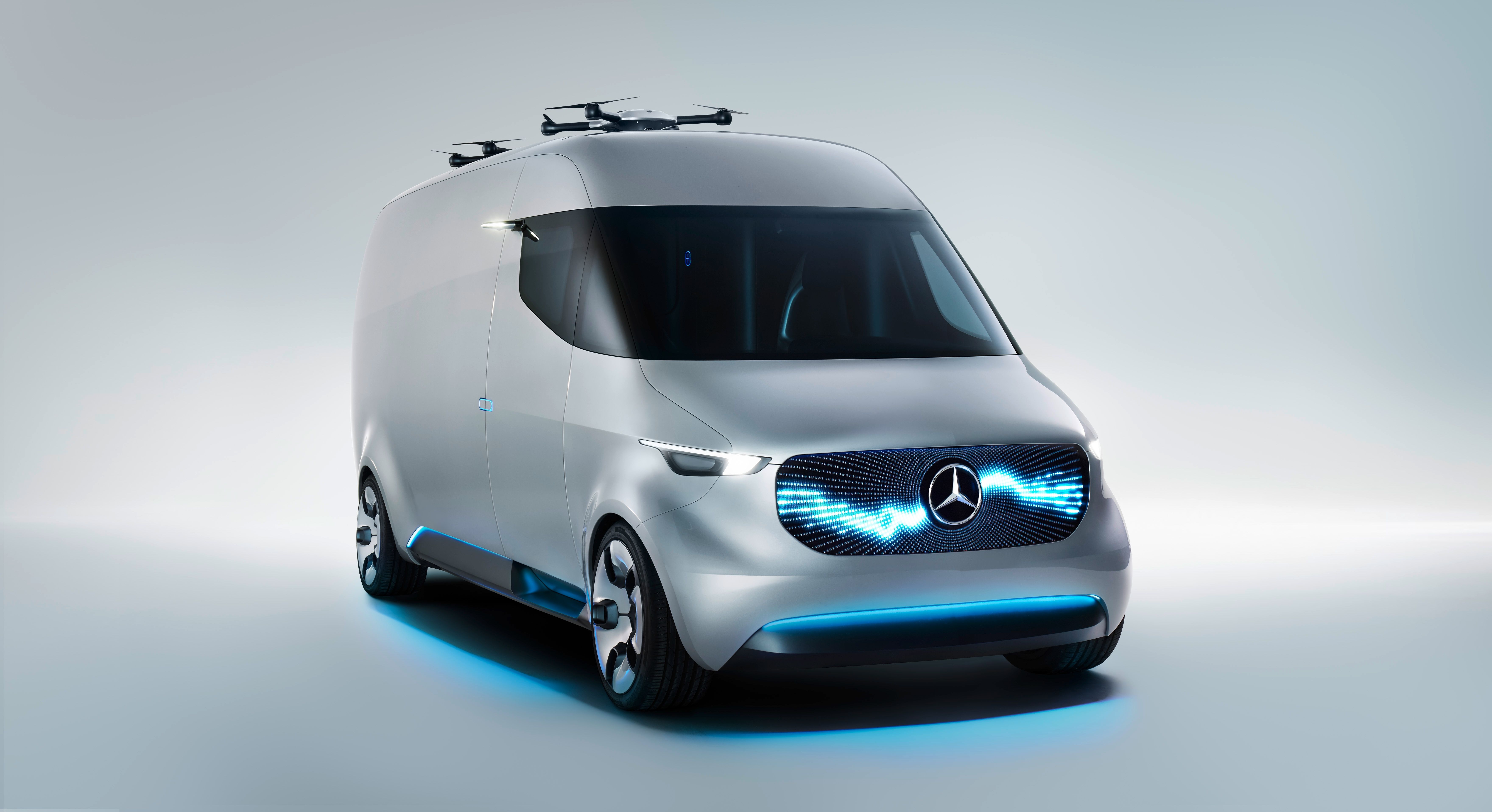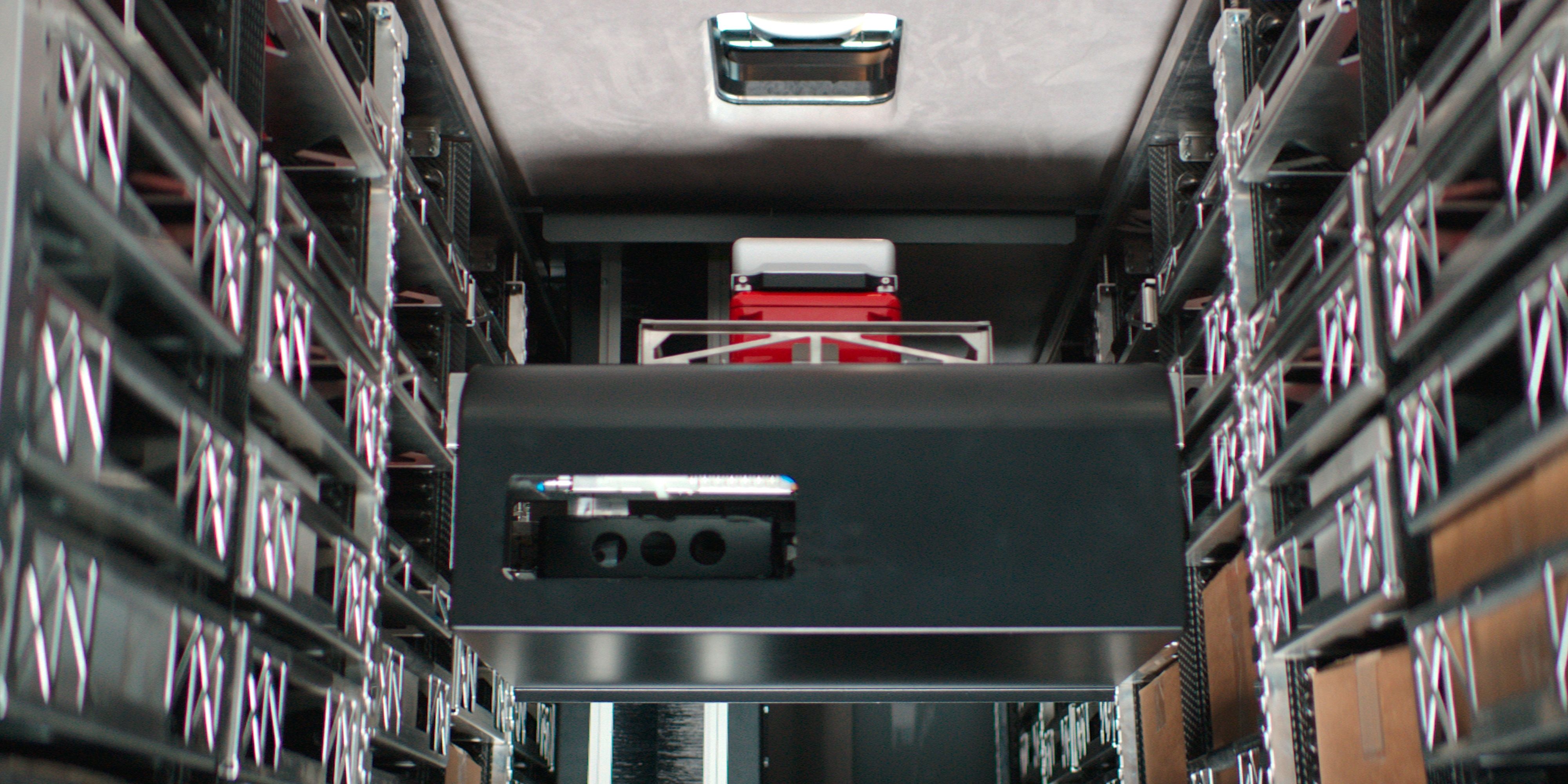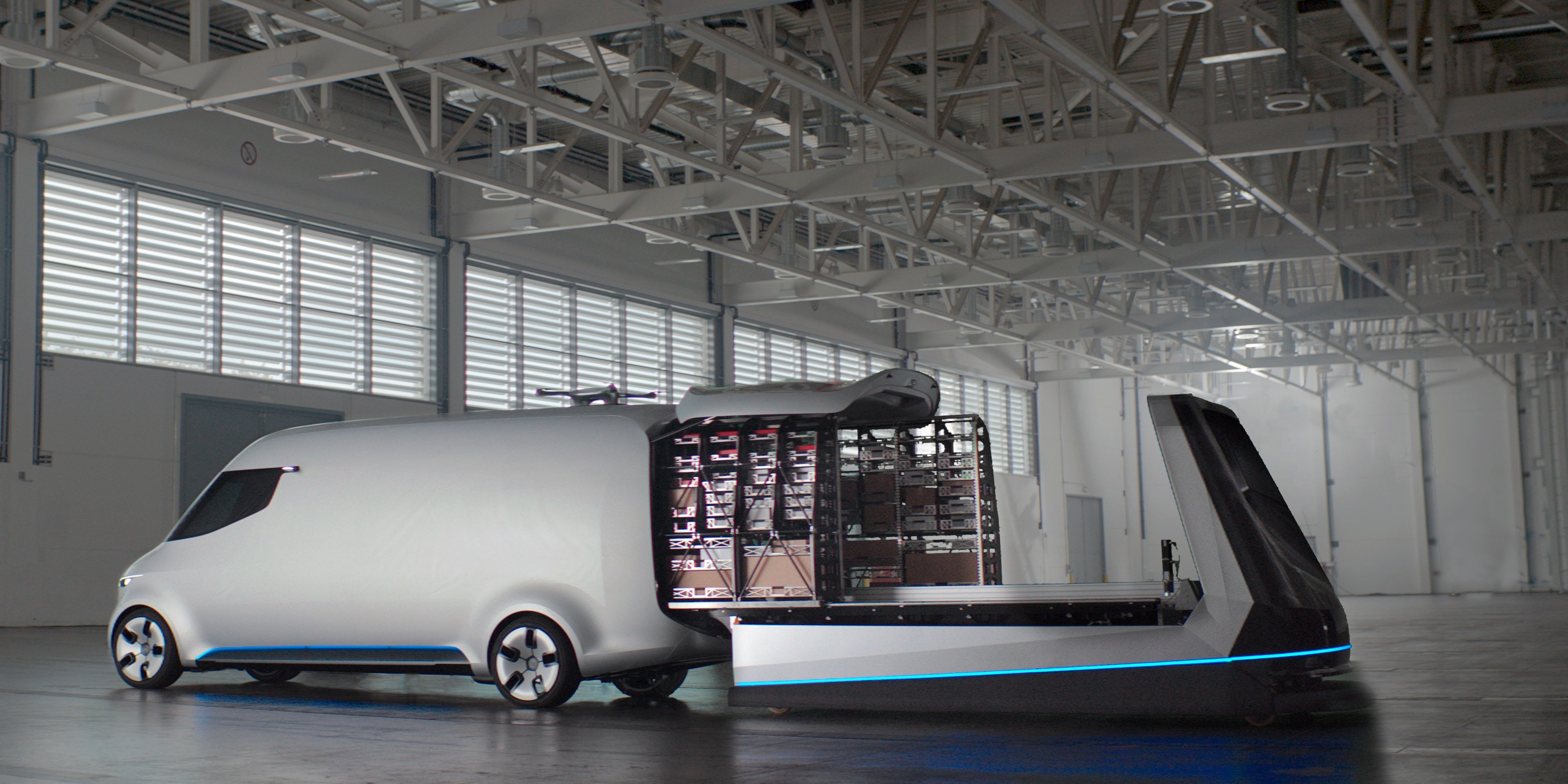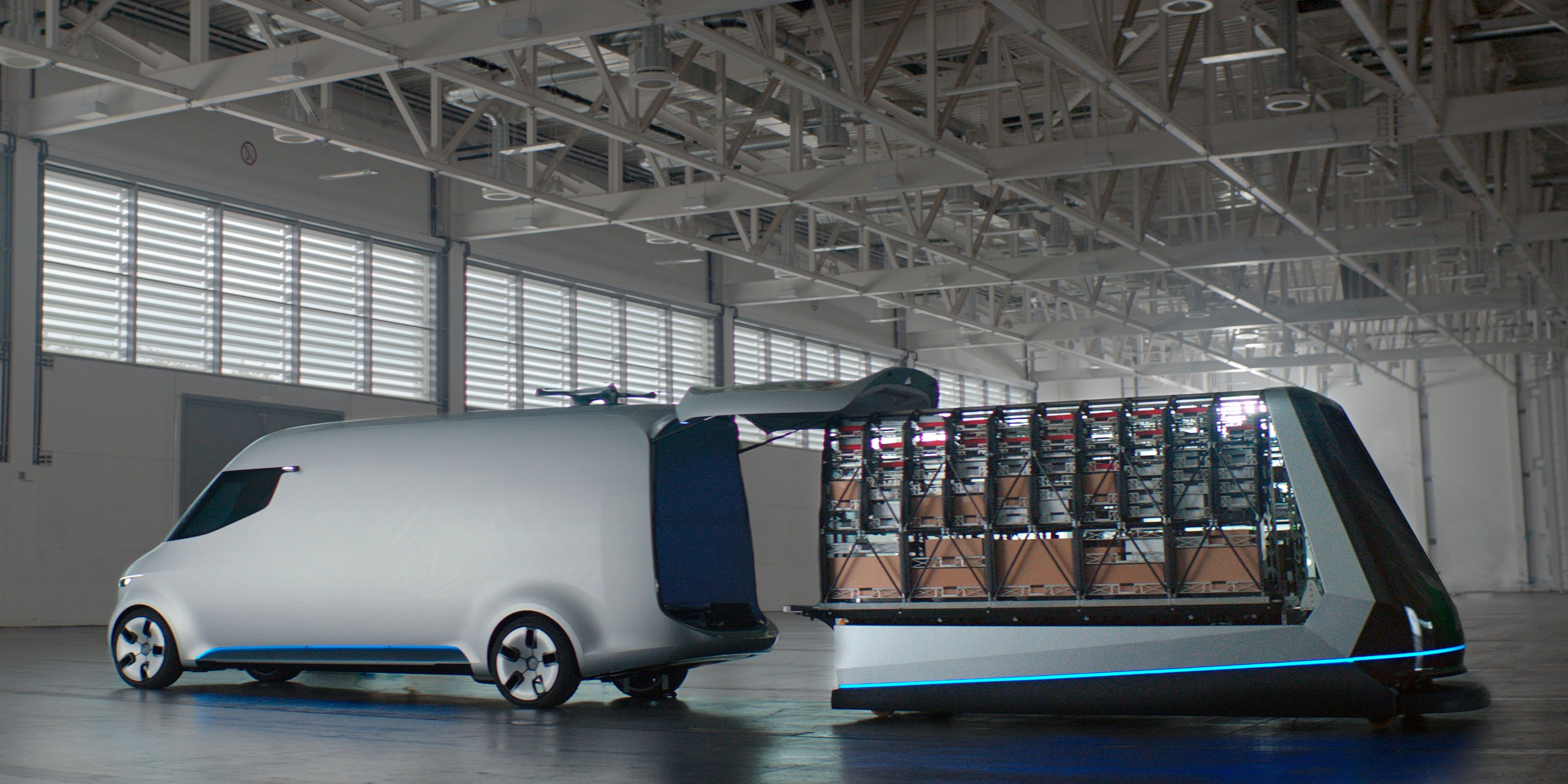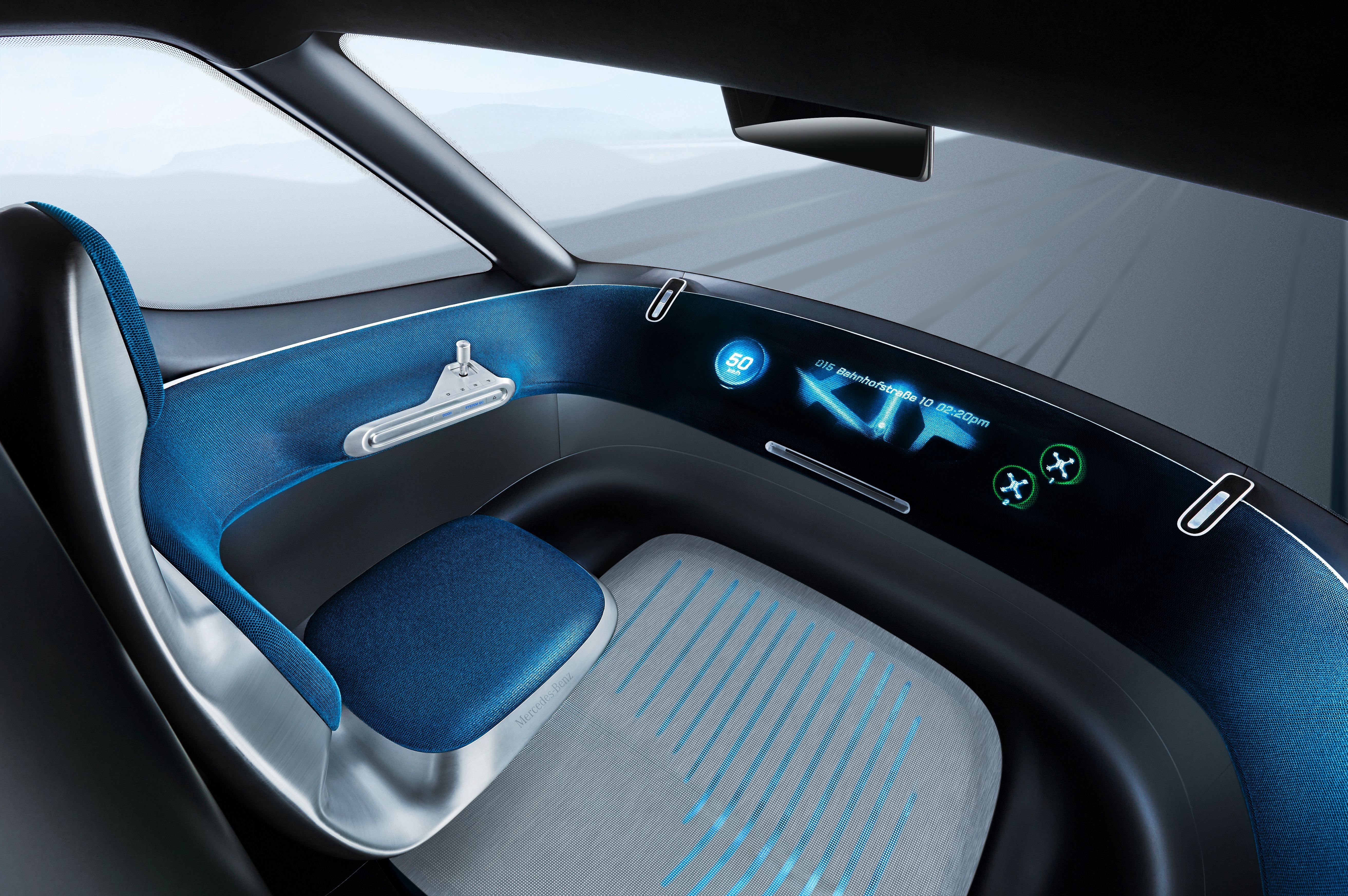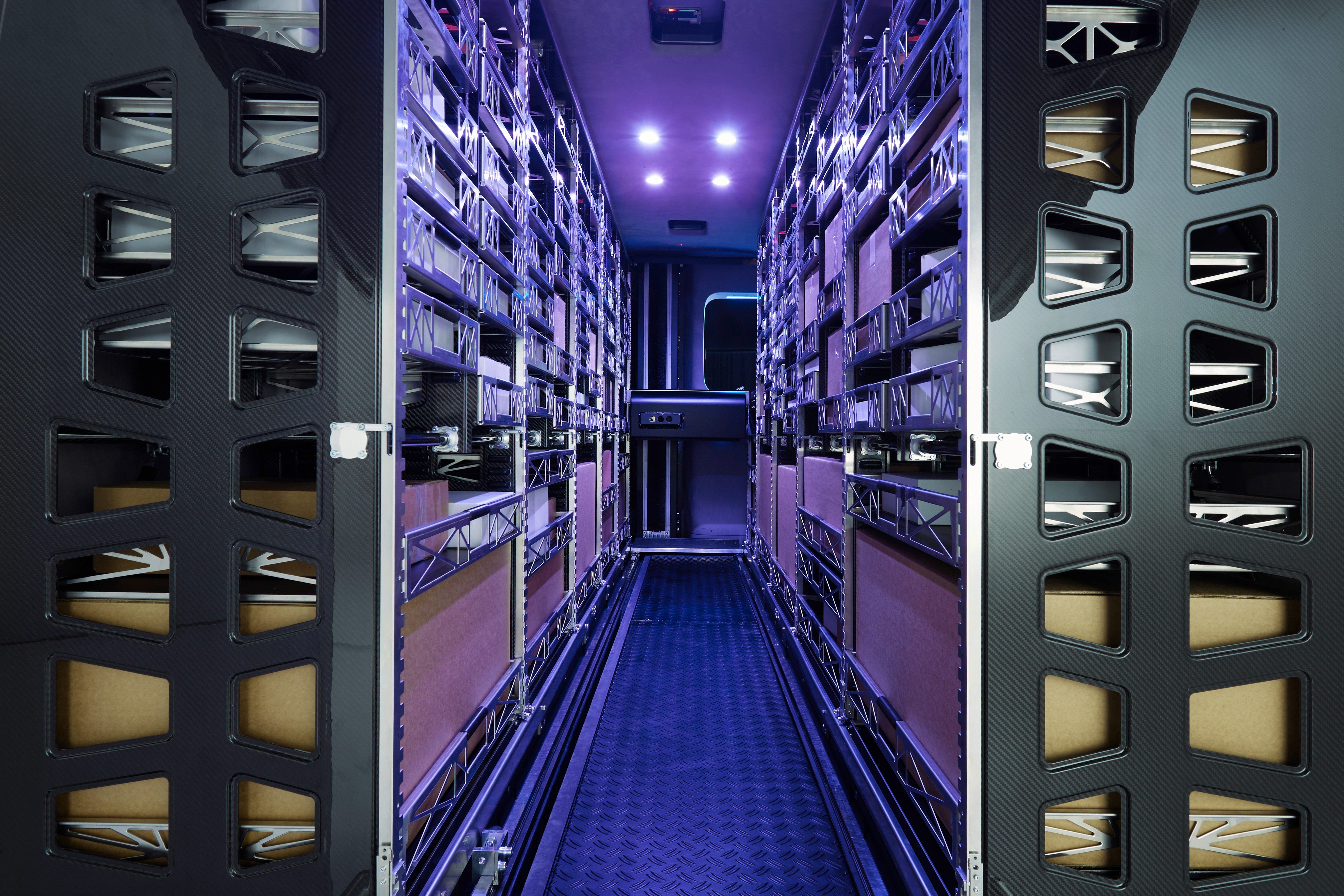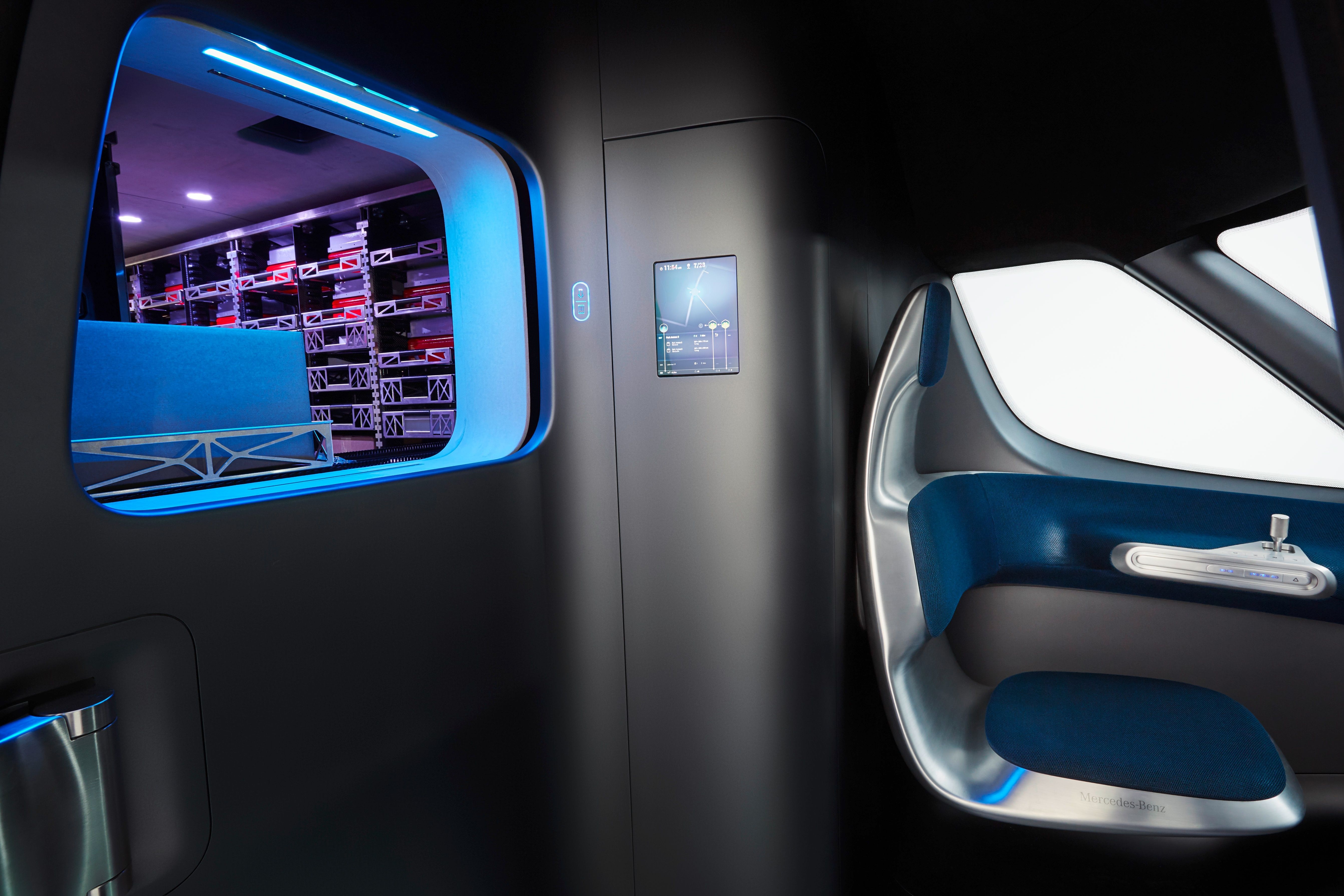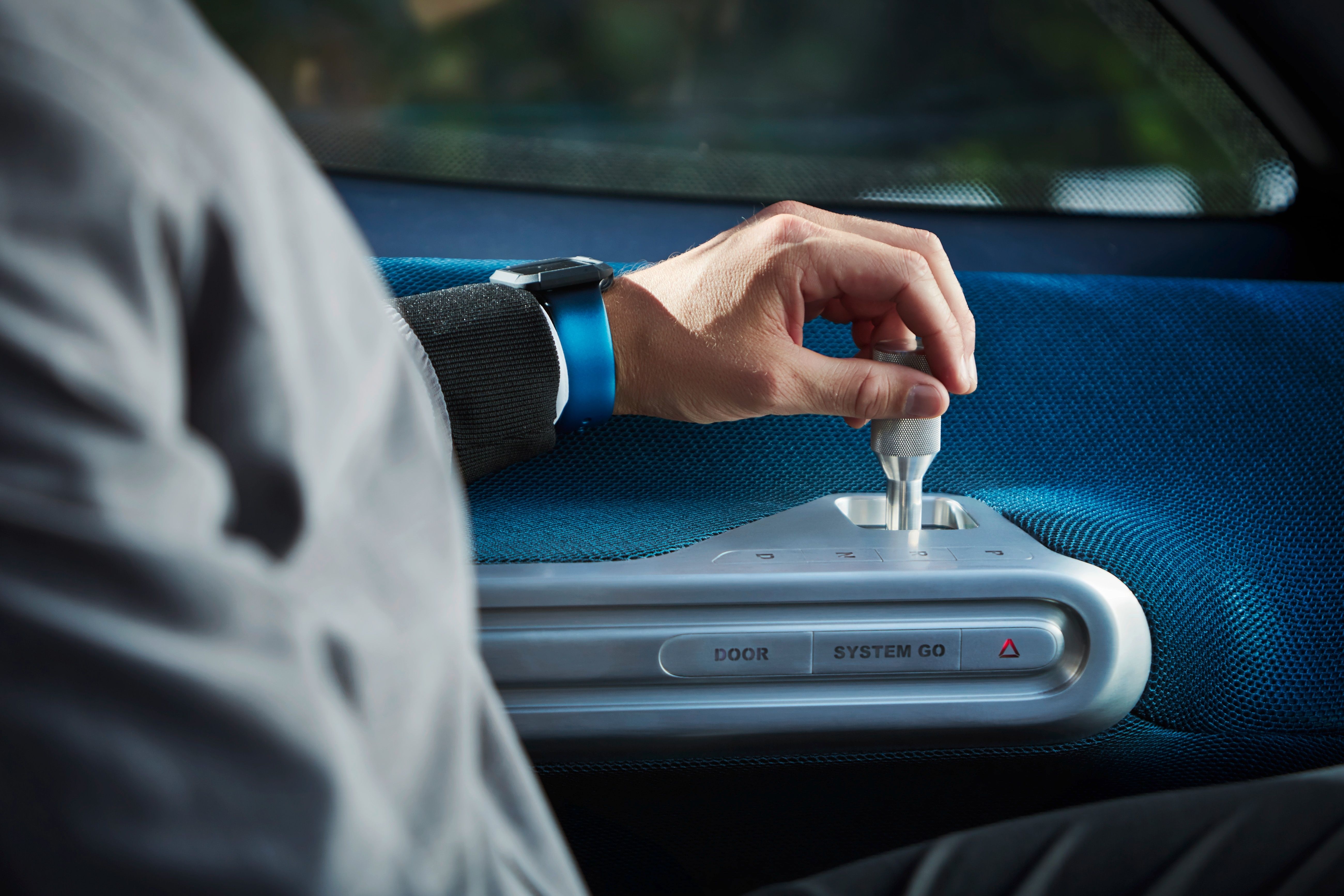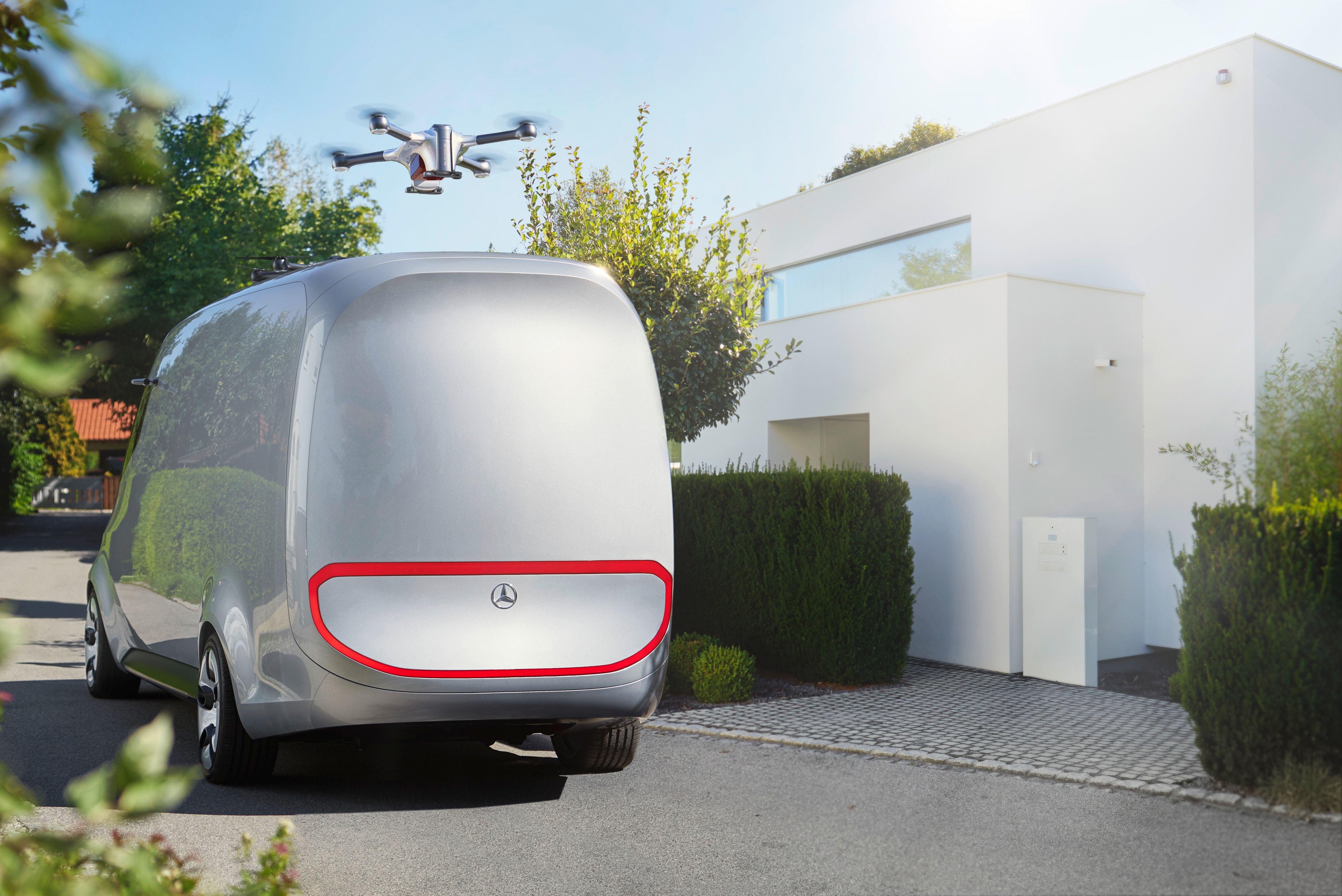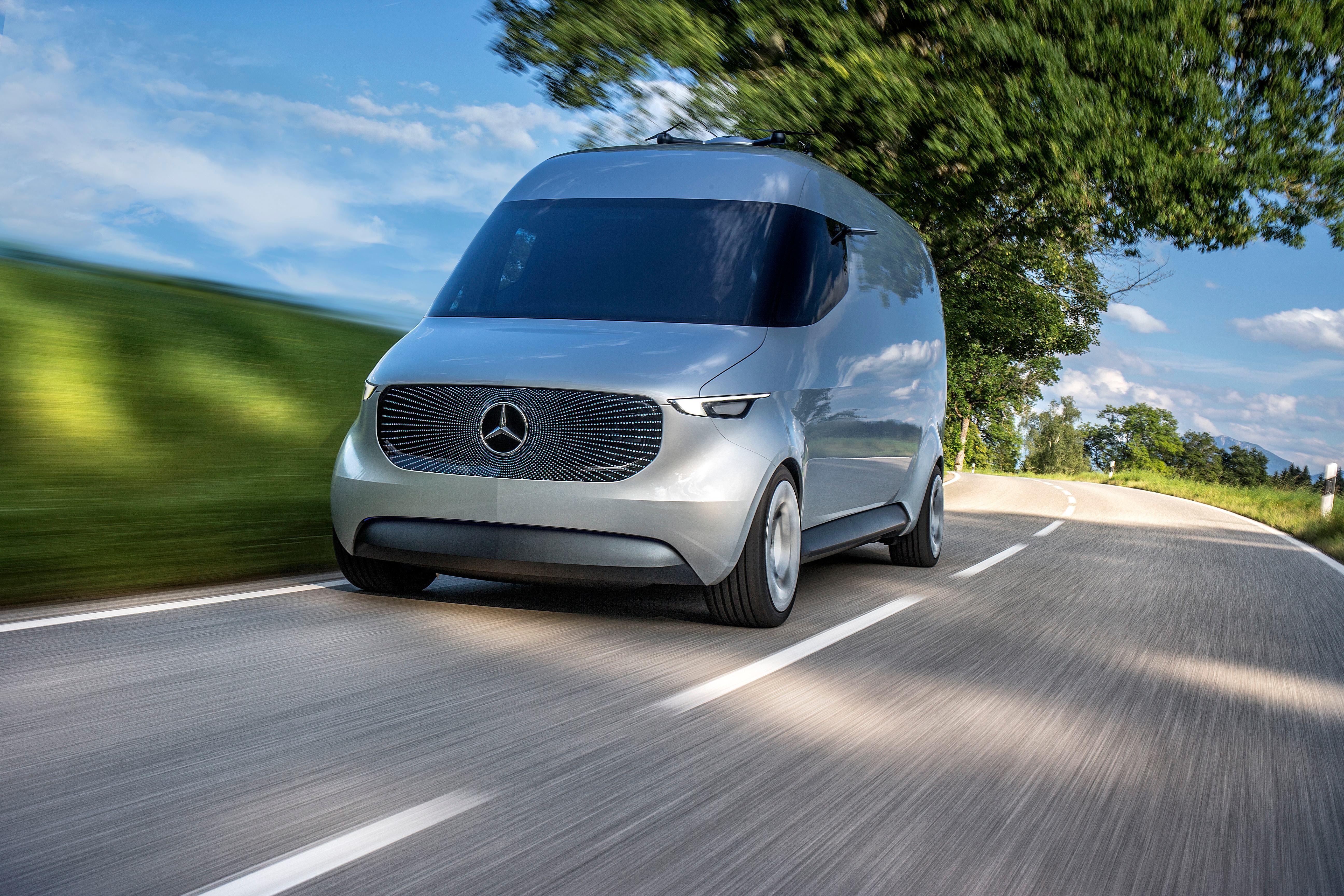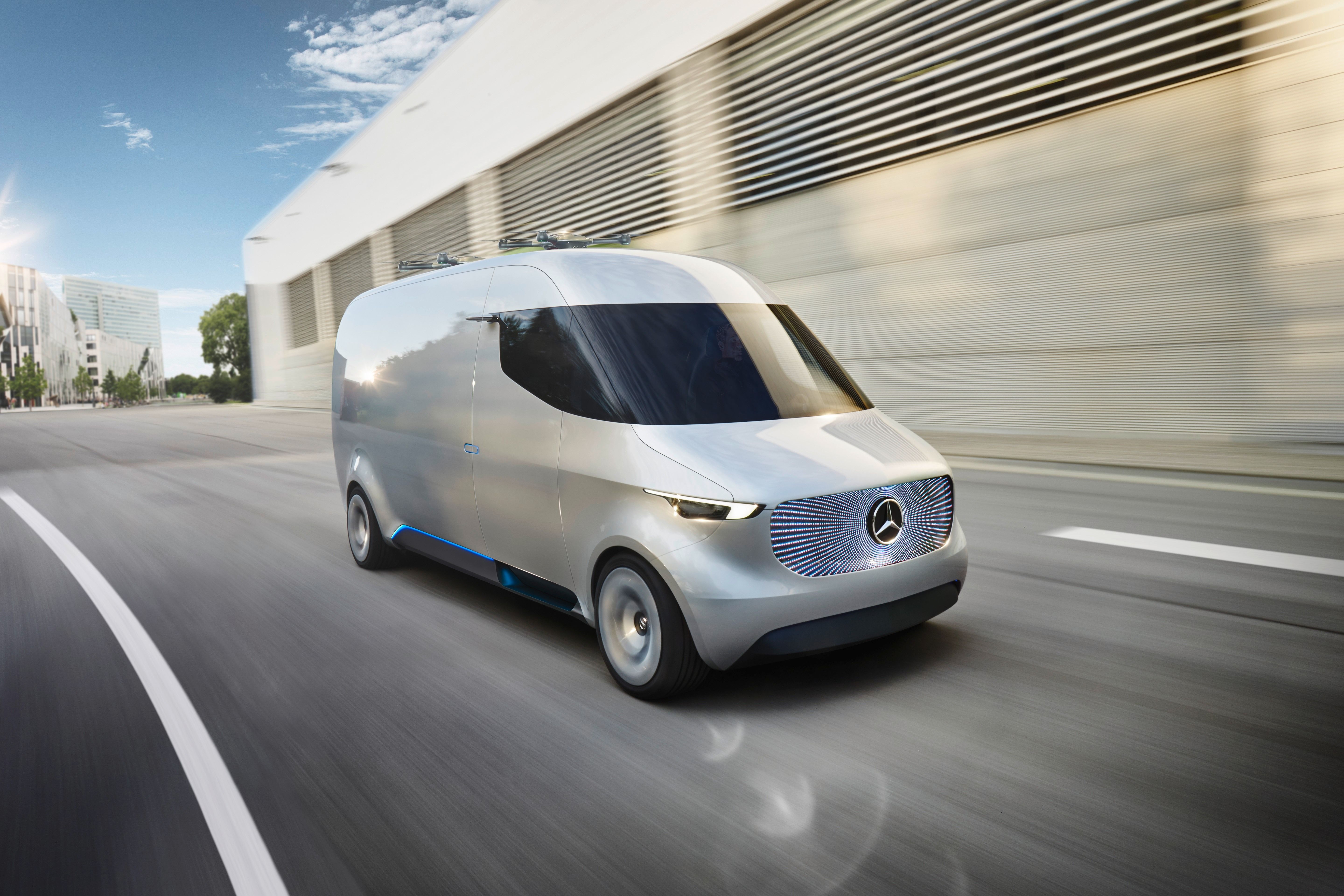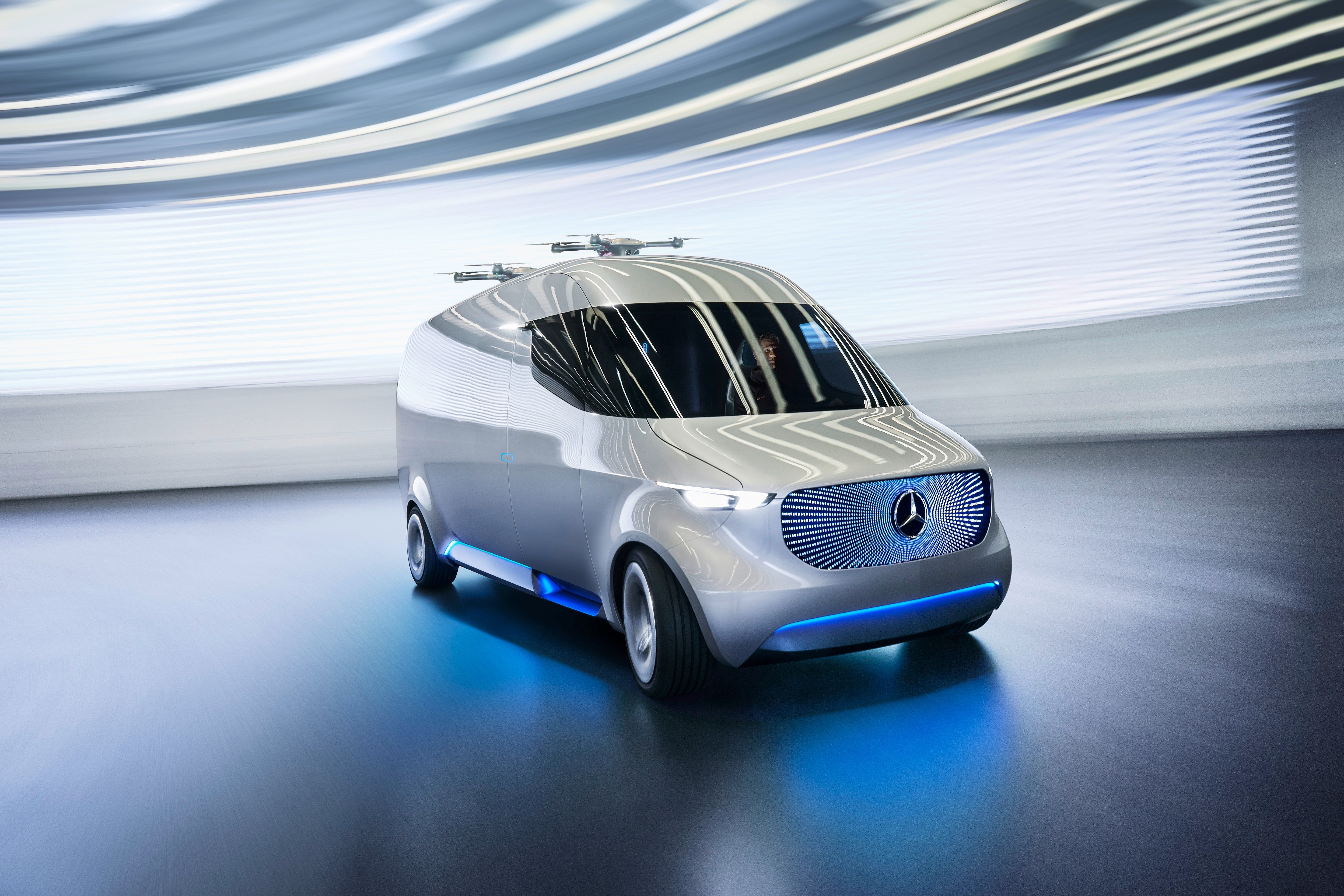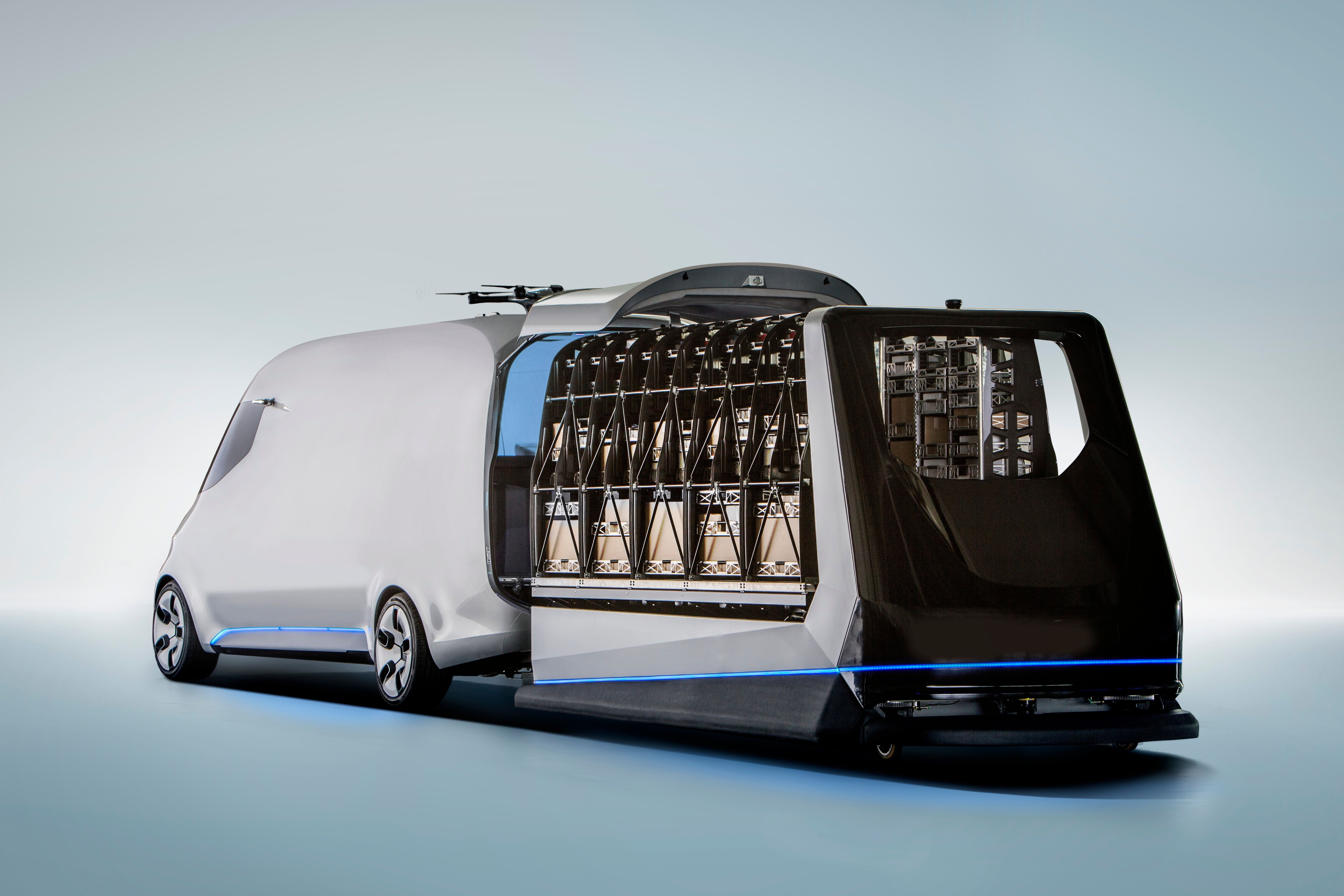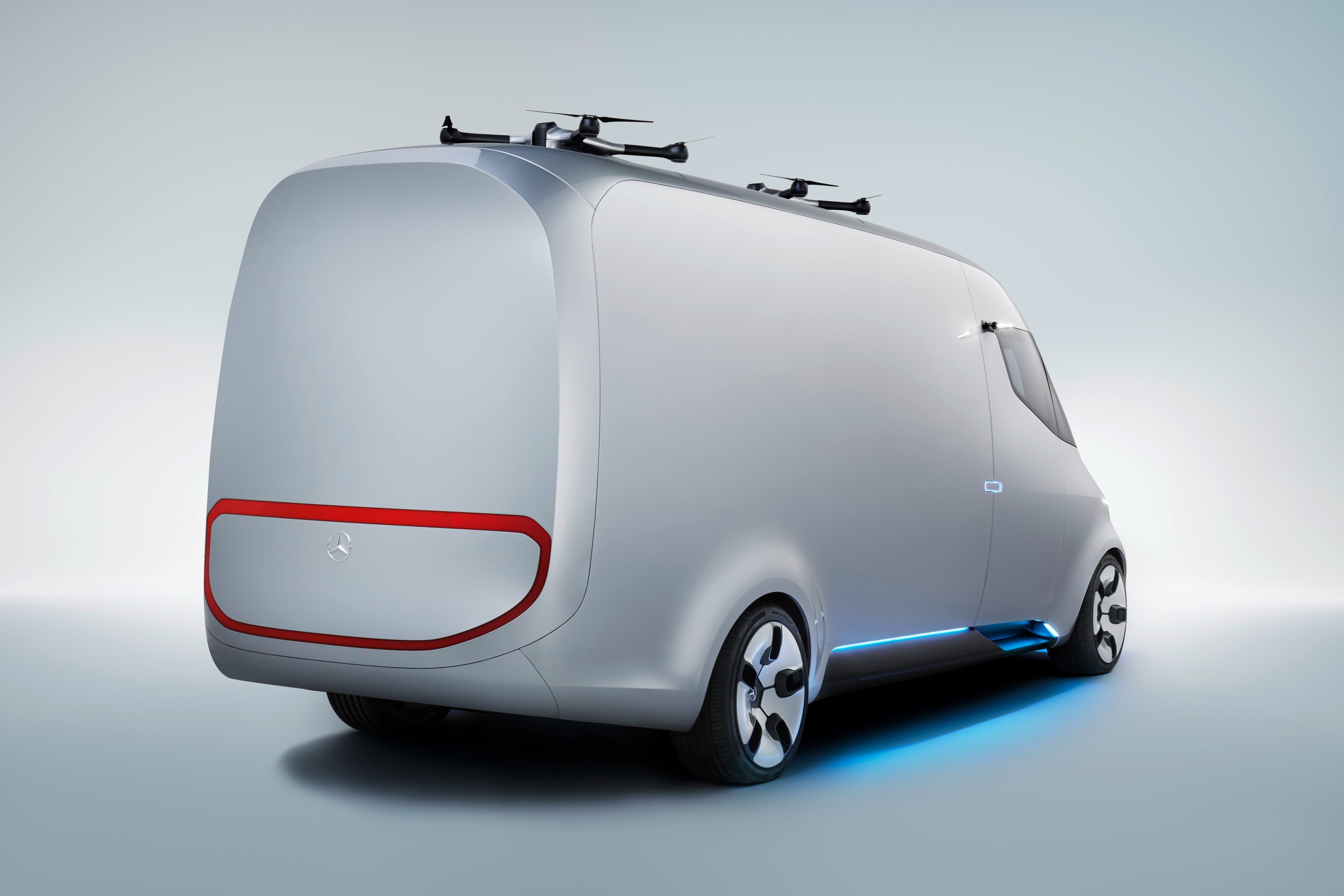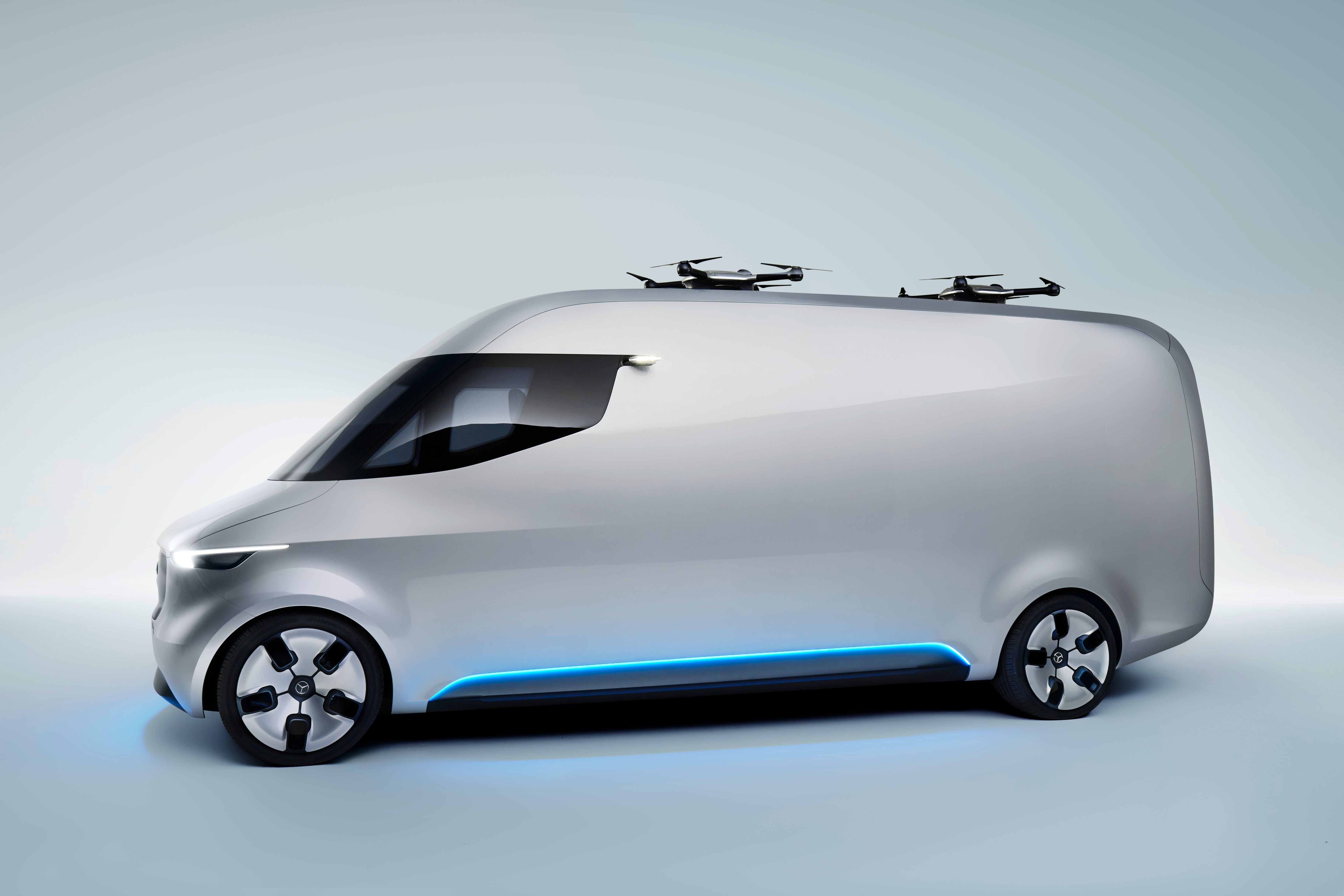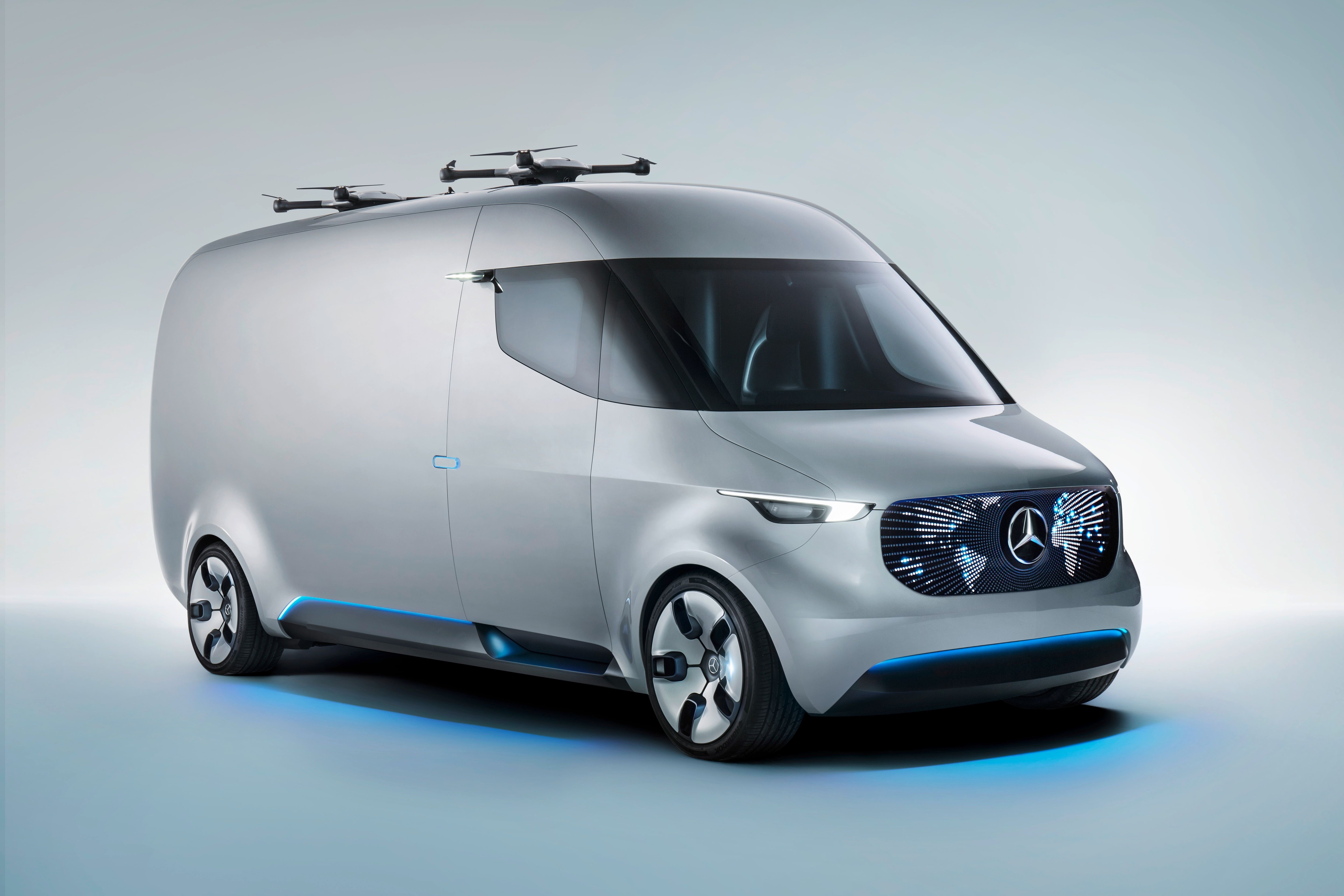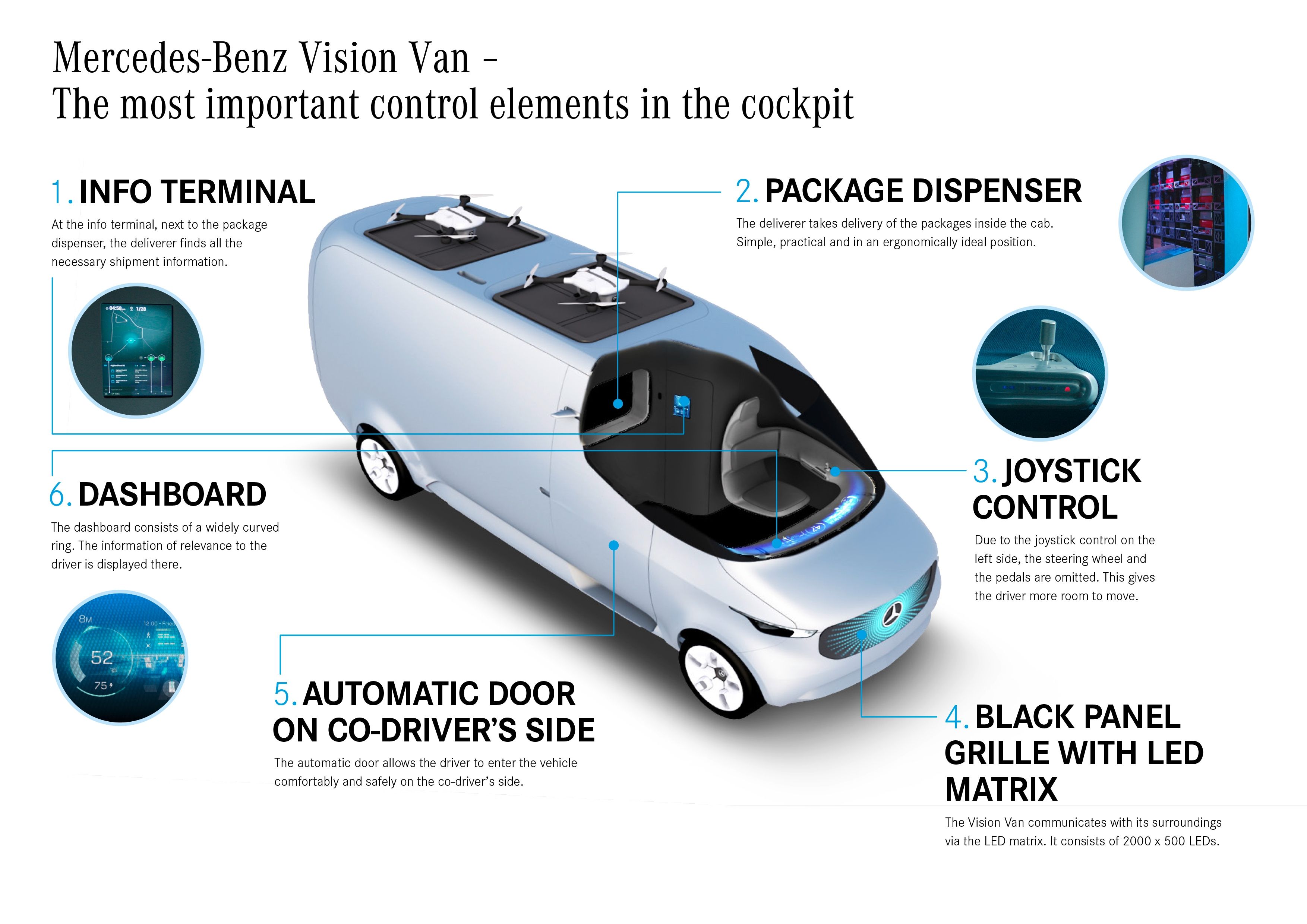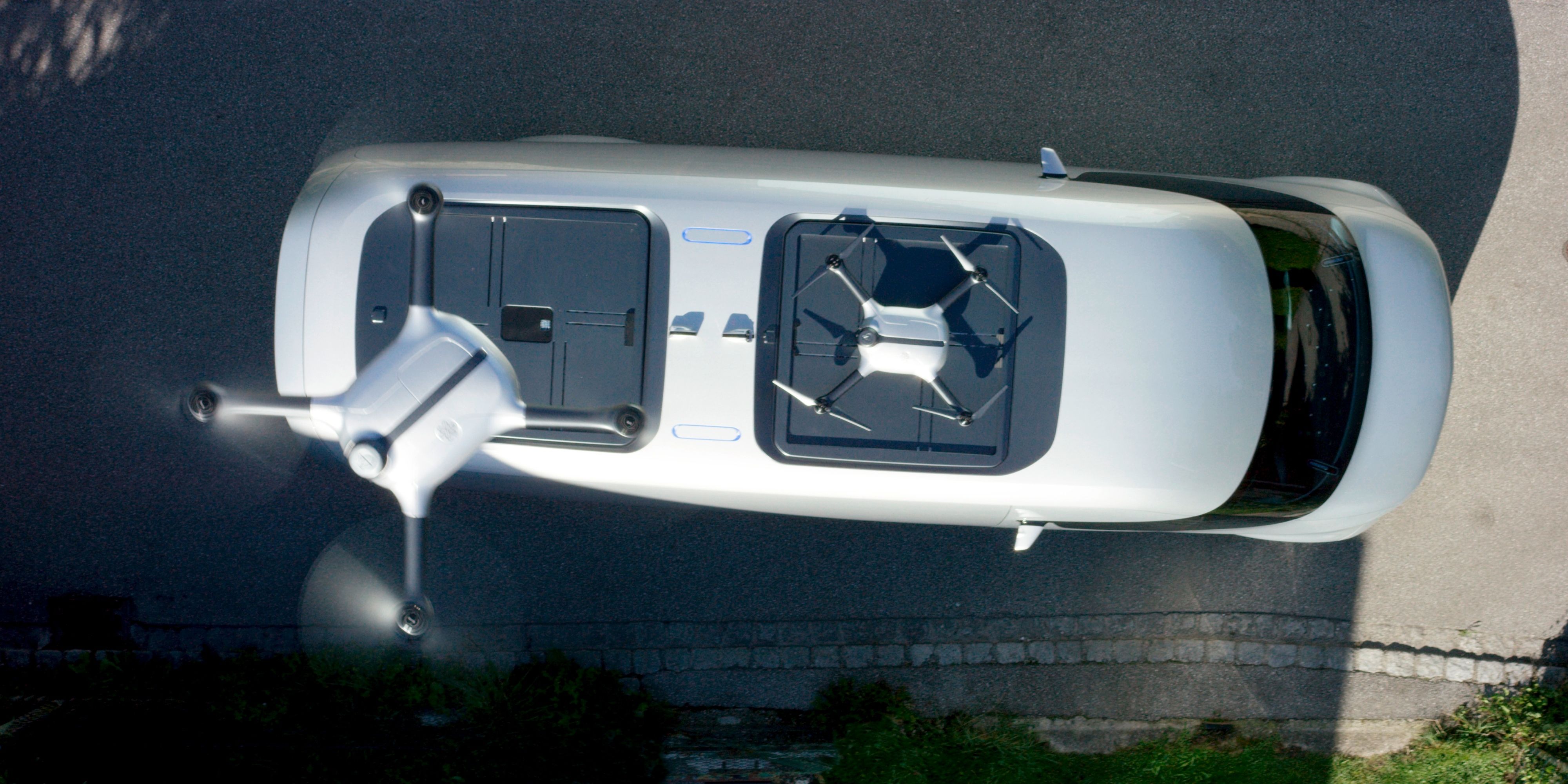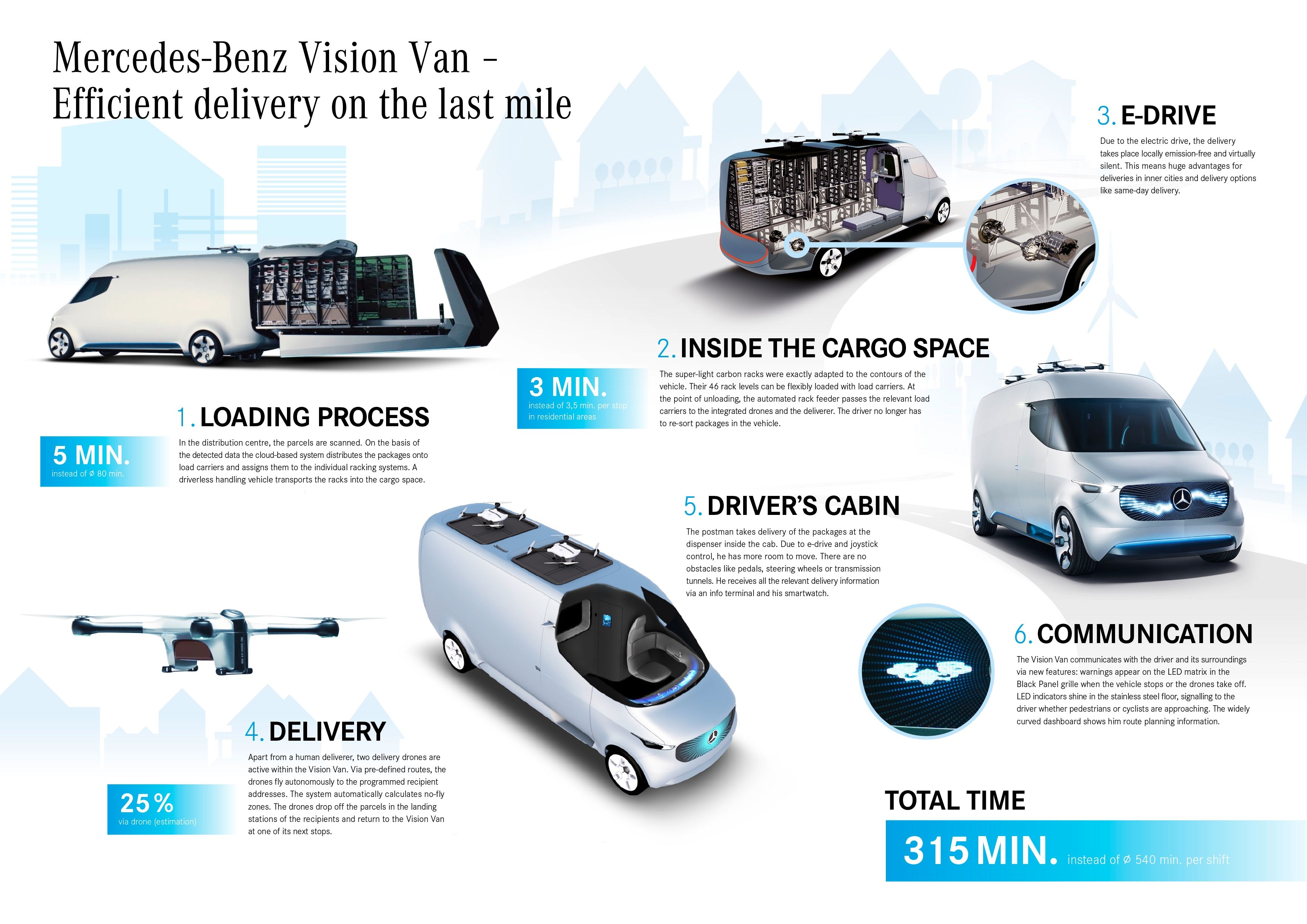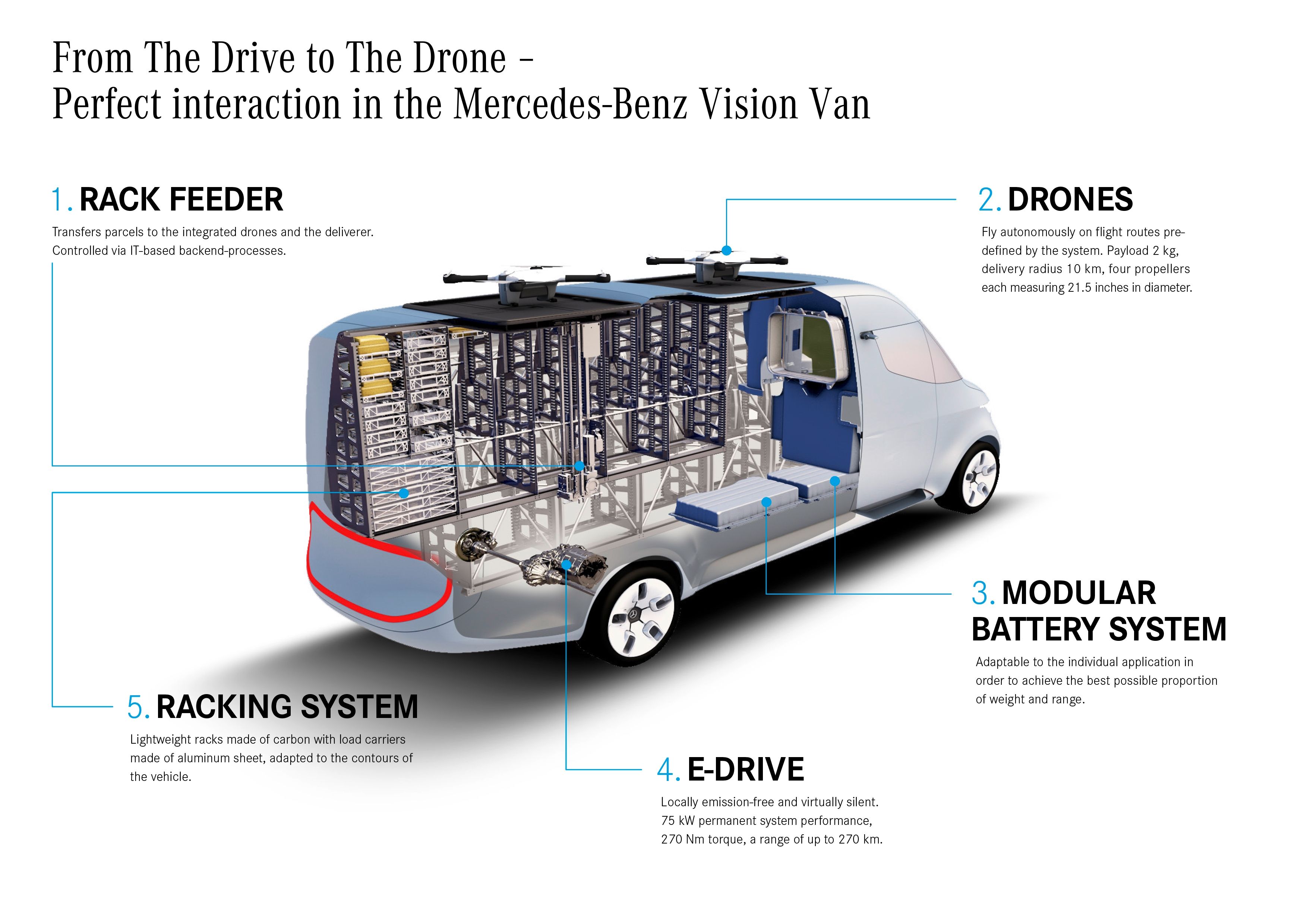In the future, everything will be faster, more efficient, and more intelligent – even when it comes to delivering that pair of cat socks you ordered off the Internet. Mercedes just announced something called adVANce, a “future initiative” looking to invest 500 million euros over the next five years in the realms of “digitalization, automation and robotics.” Where’s all that tech going? Why, to Continue reading to learn more about the Mercedes Vision Van., obviously. You see, Mercedes is imagining new ways of bringing the goods transportation industry into the 21st century, and the amorphous four-wheeled contraption you see here is the automaker’s first step in that direction. It’s hugely automated, all-electric, and there’s a squadron of drones parked on the roof. Sounds like sci-fi, but something like this concept might be closer than you think.
Mercedes says it’s already got 200 employees hammering away on ideas similar to the Vision Van, with folks stationed in Berlin, Stuttgart, and (of course) Silicon Valley. The automaker is also working with tech startups to infuse the timeworn parcel delivery model with fresh ideas and new perspectives.
So what are some of the cool ideas we can expect to see in the near future of delivery? Read on to find out.
Continue reading to learn more about the Mercedes Vision Van.
2016 Mercedes Vision Van
- Make: Array
- Model: 2016 Mercedes Vision Van
- [do not use] Vehicle Model: Array
Innovations And Ideas
What’s The Point?
These days, it’s near impossible to be doing just one thing. For example, a company can’t just be an automaker anymore, it’s gotta be a “transportation solutions provider.”
But there’s more to it than the rise of new business models. There’s also the growing pressures of urbanization – Mercedes says two-thirds of the world’s population will be living in cities by 2030. With the growth of cities comes higher demand for same-day and hourly delivery, like those associated with online food services.
There’s also the growth of e-commerce, plus the interconnectedness of the Internet of Things. New ownership models are also appearing, with transportation now incorporating novel ideas with regards to renting, leasing, and sharing.
Mercedes says it wants a slice of the action, and to that end, plans on turning the van into an “intelligent, interconnected data center on wheels” by combining automation, robotics and mobility services into one cohesive package capable of serving any vehicle-related business.
Environmentally Friendly
Unsurprisingly, Mercedes wants the Vision Van to be eco-friendly. As such, it comes with an all-electric drivetrain, which offers other benefits beyond a reduction in local emissions (check out the Drivetrain section for more).
Interconnectedness
Efficiency comes about when the left hand knows what the right hand is up to. The Vision Van takes advantage of modern information technology by connecting all the various parts of the delivery process, from “the distribution center to the consignee.”
The Van also uses onboard systems to collect data on things like the delivery route and real-time location finding, all of which can be managed from a central hub and changed at the last minute if needed.
Another interesting feature is automatic service and upkeep, with the Van autonomously sorting mechanical issues by ordering replacement parts or whatever else is needed to keep things running smoothly.
Automation
Speaking of autonomous – handing the robots the keys can have huge benefits in the world of four-wheeled deliveries.
Here’s how it works. At the distribution center, the various parcels slated for delivery are automatically scanned prior to loading, with info on the delivery address informing the automated load process for maximum efficiency. After being scanned, the parcels are sorted into large, carbon fiber racks made specifically for whatever van they are destined for. The autonomous loader then slides the fully loaded racks into the back of the van, all in a “one-shot” process that takes roughly 5 minutes to complete.
With everything already sorted and ready to go, the delivery process is streamlined considerably. Mercedes says “deliverers need to rearrange their packages (on average around 180 per load) ten times while making deliveries within a residential area and schedule approximately three to four minutes per stop,” all of which is avoided in the proposed system.
Drone Assistance
Here’s where things start to get pretty wild. You may have noticed a few drones mounted to the roof of the Vision Van. These quad-copters come from Matternet, a company based out of Menlo Park, California, that develops autonomous drone logistics systems. The drones you see pictured here are Matternet’s M2 model, which offers “automatic payload and battery exchange, intelligent routing and monitoring, precision landing and intuitive command and control,” according to Matternet’s website.
The M2 can deliver a payload up to 2 kg (4.4 pounds) at a distance of over 20 km (12 miles) on a single battery charge. The four rotors measure 21.5 inches in diameter.
Basically, once the driver has stopped to deliver a parcel by hand, the drones buzz off with smaller packages. After dropping the parcel autonomously at the recipient’s personal delivery station, the drone returns to dock with the van’s roof-mounted landing pad.
Exterior
So what is it about the actual van that makes this thing special?
Let’s start with the way it looks. My first impression of the Vision Van was that it looks somewhat similar to the Vision Concept that Merc unveiled last year at the Tokyo Motor Show. It’s got the same long, streamlined, featureless body, with large wheels, glowing LEDs, and zero panel gaps. The only “lines” you’ll find on this thing are in place to identify where the thing actually opens, either for the driver, or the cargo.
This ultra-smooth approach highlights the presence of an LED matrix installed in the nose. This grid is composed of roughly a million individual LEDs, which can be used to communicate with folks in the surrounding environment. For example, the matrix can be used to notify bystanders of a drone coming in for a landing, or simply as advertisement for the company that owns the vehicle.
In back is a large, circular ring that takes on the role of taillight.
Unlike the passenger-oriented Autonomous Vision presented last year in Japan, I feel like the future aesthetic that Mercedes is going for here actually kinda works on something like a van. These workhorses are supposed to be all about form following function, whereas personal transportation should, in my opinion, have an extra individual touch.
Interior
Speaking of all business, the interior on this thing looks like its ready to get the job done – if you’re delivering to an address on Neptune, that is. Looking at the pictures, I can’t help but think, “shuttle craft.”
The driver is positioned on the left-hand side, with a single seat for when the vehicle is in motion. Surrounding the driver is a broad dashboard that wraps across the full width of the cabin, displaying pertinent information through high-tech digital displays.
Interestingly, the Vision Van uses a joystick for control, replacing the traditional steering wheel and pedals and offering greater space for the driver to move around. Behind the driver is a small window through which larger parcels are accessed. The parcel is automatically dispensed thanks to an autonomous sorting system built into the carbon fiber loading rack, making it much easier to get the right package quickly.
Next to the parcel window is an information panel that displays all required shipping information (“Leave it under the mat!”). The driver exits on the right-hand side by way of a single automatic door.
On the floor are more LEDs, which light in certain colors to warn the driver of the presence of pedestrians or cyclists.
Drivetrain
Making this thing go is an all-electric powertrain. Under the floor is a series of battery packs, which are modular and optimized to fit each given application (factors like the vehicle weight and required delivery range are two factors to consider here).
The electric drive unit produces 75 kW (roughly 100 horsepower) and 270 Nm of torque (roughly 200 pound-feet). All that juice is routed to the rear axle for motivation. Range per charge varies between 80 km (roughly 50 miles) and 270 km (roughly 168 miles).
Not only does all-electric power equate to lower local emissions, it’s also silent, which allows the Mercedes Vision Van to deliver goods late at night when there might be restrictions on traffic.
Conclusion
Beyond the joystick control and weird styling for the exterior and interior, the Mercedes Vision Van isn’t really that outrageous, if you think about it. All-electric power seems to be the direction most makes are headed – hell, Tesla is even talking about making a battery-powered semi truck. Throw in the added benefits of autonomous loading and parcel sorting, and this thing looks like it’s making the right moves.
“But what about the drones?” you might ask. I’m getting to that. This isn’t the first time we’ve seen the inclusion of an unmanned aerial vehicle with a car. Previous examples include Rinspeed Etos Concept from 2015, as well as the Renault Kwid concept from 2014. Rinspeed used the drone to do stuff like pick up flowers for a significant other, while Renault used the drone to scout out traffic jams.
Okay, so it’s just a future study. But the fact Mercedes is planning on pouring a half billion euros into ideas like this tells me its more than just a PR grab. This very well could be the way forward for the transportation of goods – at least partially. After all, if it helps a business run smoothly, that’s all the motivation needed to make it a reality.
Take away the concept gloss, and this thing has a few very interesting ideas. What do you think? Let us know in the comments.

